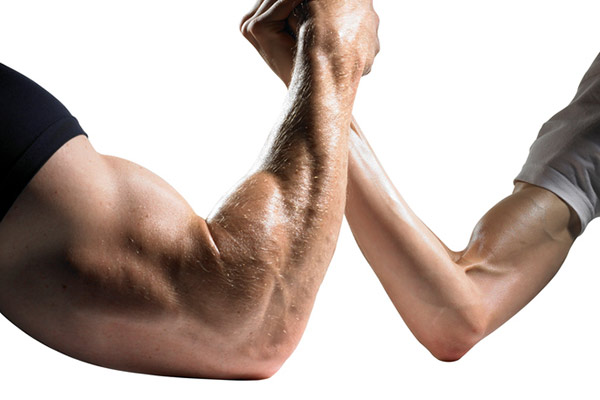I have never been one to accept the limitations that life, or others, placed on me as I was growing up and weak, lagging body parts are no exception. Here are 5 rules for making turning lagging body parts into your strongest muscle groups.
Trainers: Ashley Conrad, innovator of the Clutch programme and Altug Kop, WBFF Pro Fitness Model and TRAIN Digital Editor
Make lagging body parts stronger? Can it even be done?
Ashley: Over the years I’ve had numerous negative comments directed at me, including, ‘Ashley, you’re not a good enough athlete to play basketball at the University of Southern California, so maybe you should aim a little lower.’ Or there was, ‘Ashley, you don’t know anyone in the fitness industry, so how can you possibly become a successful trainer?’
And I’ve even had, ‘Ashley, you don’t know anything about supplement manufacturing, so how are you possibly going to start a supplement company?’
Admittedly, it would make life so much easier at times to just accept those perceived weaknesses, whether we form them within or they come from those around us.
But the thing is, whether it be a world-class athlete or the CEO of a multi-billion dollar company, people who achieve great things do not accept their weaknesses; in fact, they work relentlessly every day to change and improve them.
Work ethic + a dash of honesty will turn weak body parts into strong muscles
Altug: If you’re to overcome weak body parts there’s absolutely no doubt that you’ll need a sickening work ethic. After all, if your lagging body part really is a weak point, then be prepared for some hard grind ahead.
Yes, weak muscle groups can be because you’re training them sub-optimally. Maybe you’re not training them frequently enough or when you are, you’re not feeling them contracting as well as you do your better growing muscles.
But, and this is an important but; ignoring a cold, hard dose of truth can also set you up for unrealistic expectations and disappointment.
What do I mean? Well, the fact is that some people have weaker body parts by design. The shape of your muscles and their potential is largely down to the genetic hand that you were dealt.
Now, if you were dealt a royal flush at the muscle building high stakes table, then you’re in luck. Chances are though, if you’re experiencing quality growth in most area’s of your body, but there’s one body part that just won’t grow despite feeling great contractions and pump during your workout, you’ve been dealt a bad card.
Pick your head up; this is no time for excuses. This doesn’t mean that the muscle won’t grow. Nor does it mean that tweaks can’t be made to ignite growth. What it does mean, though, is that the shape of your muscles are not changeable. Where your muscles insert and where they originate will always be. Why do you think Phil Heath continues to beat out Kai Greene at the Mr Olympia?
It’s not because Kai is smaller than Phil, trust me. There’s just that fuller, rounder look to Phil’s muscles that is his genetic gift. It’s ok – Kai is considered elite and has overcome almost all of his genetic deficiencies to become, arguably in many people’s eyes, the best bodybuilder on the planet. There is hope for you.

With that in mind, if you’re ready to turn your weaknesses into your greatest strengths, read the five golden rules below, taken from Ashley’s world-renowned training program, Clutch and the scientific evidence from our TRAIN Digital Editor, Altug Kop.
Rule 1: Focus totally on the weak body part you’re working on
Don’t ‘zone out’ during any part of your workout. Staying 100% locked in and focused during each portion of each rep is absolutely critical to maximizing the engagement of muscle fibers, and to ensure proper isolation of the weak muscle group being worked. This is the foundation of the mind-muscle connection.
After all, one of the reasons that many develop weakness is because they simply don’t have the mind-muscle connection they need to provide the stimulus for growth. If you need to drop the weight, drop it (as well as your ego) until you feel the work in the right place.
Rule 2: Never accept a mediocre set
I hate mediocrity because it means you are living or acting below your potential. In regards to your body, accepting mediocrity is nearly always what is standing between you and your goals.
That being said, let’s say you are doing a set of shoulder raises and the recommended rep range is 12–15. If you get to 12–15 with ease, don’t stop the exercise! Either keep going until failure or super-set the exercise with another shoulder movement until you feel muscle fatigue.
Once you’re able to do this though, it really is time that you increased the weight and started at the bottom of the 10-12 range again and work your way back up to 15 (in the 10-15 rep range example). This is progressive overload and is needed to provide your weak muscles with new stimulus for growth.
Rule 3: Make your own rules
What works for one person doesn’t always work for another. With my own body (Ashely), I found that to achieve maximum definition and ‘pump,’ super and drop-sets reign over lifting heavy weight.
However, if I simply followed what everyone else advised me to do on account of my ectomorph body type, I’d probably still be squatting 295lb, like I did in college, and have puffy, water-retained looking muscles. But luckily for me, I am a glutton for discovery and new information.

Science will always provide us with sensible recommendations but that shouldn’t discourage you from figuring it out yourself too like the boys in the 70’s did. Nobody is going to tell Arnold that his workouts weren’t effective are they?
Oftentimes science confirms what we already know and have been practically applying for decades. As long as you stay safe, log your progress and results, don’t be afraid to try out new stuff.
The point is this: find the exercises, rep ranges and techniques that work best for your weak bodyparts, because fitness and transformation is not a one-size-fits-all equation.
Rule 4: Don’t overtrain your weak body parts, but do add frequency
A meta-analysis by Dr Brad Schoenfeld showed that training a lagging body part (and any muscle group for that matter) twice a week is far superior for muscle growth versus once a week.
But, if you don’t allow a muscle group adequate rest, it can’t repair properly and will therefore likely not grow or get stronger. Again, if you are following all of the prior rules, there’s no need to work your problem muscle group more than two or three times per week to achieve amazing gains in strength, power and definition.
Rule 5: F*** it. Overtrain your weak body parts
Perhaps in contradiction with rule 4, but also in compliance with rule 3. Sometimes we just have to throw the rulebook out the window.
Actual overtraining is extremely difficult to do in a bodybuilding setting, but when it happens, it’s not pretty – you’ll stop gaining mass, be more prone to adding body fat, get weaker, release more stress hormones, be fatigued all day…need I go on?
Luckily, there is a smart way to ‘overtrain’ that is actually beneficial. It’s called ‘overreaching’ and is a purposeful addition of volume to your regular workout.
For between 4-8 weeks, using additional sets/reps beyond what your body is used to can reveal brand new gains when you taper back down to your regular volume of work after this phase. The difference between a strategic overreaching phase and overtraining is that overreaching is purposeful. Overtraining is something you don’t realise is happening for the most part.
Try overreaching. Add an extra set to each exercise you currently do for 4-8 weeks and enjoy the gains for your lagging body parts.
For more content on strengthening lagging body parts and muscle groups, get TRAIN magazine direct into your inbox every month for free by signing up to our newsletter







